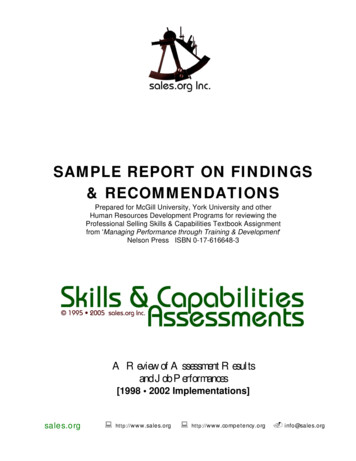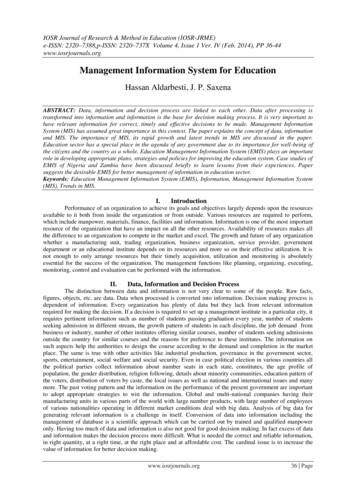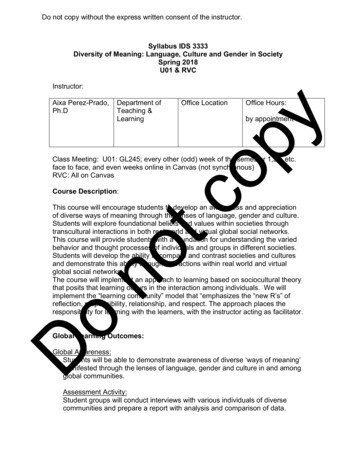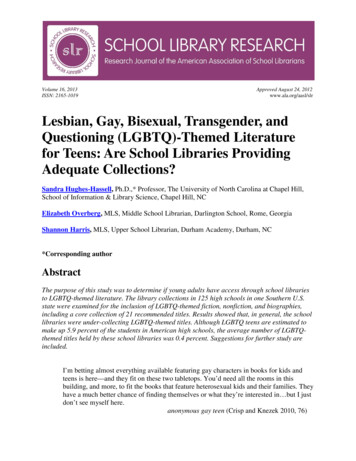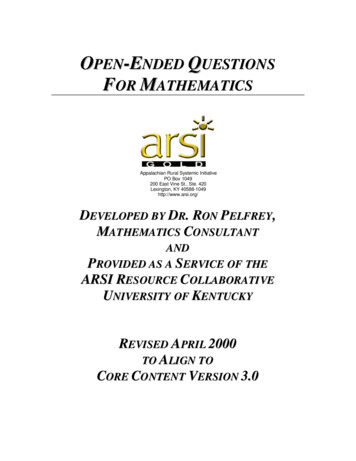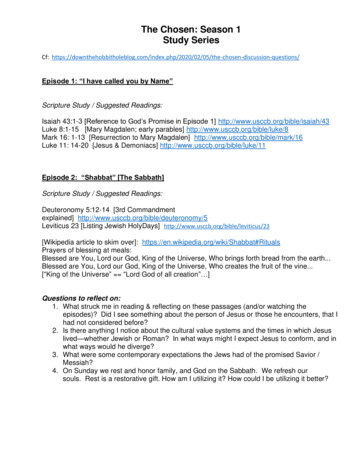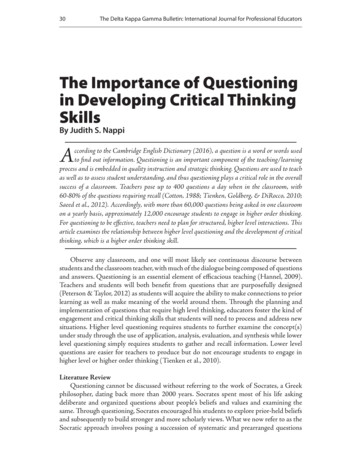
Transcription
30The Delta Kappa Gamma Bulletin: International Journal for Professional EducatorsThe Importance of Questioningin Developing Critical ThinkingSkillsBy Judith S. NappiAccording to the Cambridge English Dictionary (2016), a question is a word or words usedto find out information. Questioning is an important component of the teaching/learningprocess and is embedded in quality instruction and strategic thinking. Questions are used to teachas well as to assess student understanding, and thus questioning plays a critical role in the overallsuccess of a classroom. Teachers pose up to 400 questions a day when in the classroom, with60-80% of the questions requiring recall (Cotton, 1988; Tienken, Goldberg, & DiRocco, 2010;Saeed et al., 2012). Accordingly, with more than 60,000 questions being asked in one classroomon a yearly basis, approximately 12,000 encourage students to engage in higher order thinking.For questioning to be effective, teachers need to plan for structured, higher level interactions. Thisarticle examines the relationship between higher level questioning and the development of criticalthinking, which is a higher order thinking skill.Observe any classroom, and one will most likely see continuous discourse betweenstudents and the classroom teacher, with much of the dialogue being composed of questionsand answers. Questioning is an essential element of efficacious teaching (Hannel, 2009).Teachers and students will both benefit from questions that are purposefully designed(Peterson & Taylor, 2012) as students will acquire the ability to make connections to priorlearning as well as make meaning of the world around them. Through the planning andimplementation of questions that require high level thinking, educators foster the kind ofengagement and critical thinking skills that students will need to process and address newsituations. Higher level questioning requires students to further examine the concept(s)under study through the use of application, analysis, evaluation, and synthesis while lowerlevel questioning simply requires students to gather and recall information. Lower levelquestions are easier for teachers to produce but do not encourage students to engage inhigher level or higher order thinking (Tienken et al., 2010).Literature ReviewQuestioning cannot be discussed without referring to the work of Socrates, a Greekphilosopher, dating back more than 2000 years. Socrates spent most of his life askingdeliberate and organized questions about people’s beliefs and values and examining thesame. Through questioning, Socrates encouraged his students to explore prior-held beliefsand subsequently to build stronger and more scholarly views. What we now refer to as theSocratic approach involves posing a succession of systematic and prearranged questions
Generational Issues for Educators31designed to help students to reflect and therefore improve their thinking and gain a betterunderstanding of their own beliefs and ideas.An instructor using the Socratic approach is not looking for a specific correct answerbut is, in fact, inspiring students to reflect on their thinking. Socrates respected theexperiences, understandings, and knowledge that individuals had gained through lifeexperiences and believed that, through questioning, previously attained knowledge couldbe used to develop thinking supported by rationales and logic (Byrne, 2011).Tienken, Goldberg, and DiRocco (2009) focused on the procedures of questioning andcited a distinction in the cognitive processes used when asked recall or lower level questionsas opposed to higher level questions that required students to analyze, synthesize, andevaluate. Higher level questioning that requires students to analyze, synthesize, evaluate,categorize, and/or apply information has been found to be particularly advantageous tostudent learning, yet higher level questions are rarely used (Peterson & Taylor, 2012;Tienken, et al., 2010). Generally, higher level questions do not have one correct answerbut encourage students to engage in critical thinking. Lundy (2008) found that addressinghigher level questions is essential to student learning. In addition, Lewis (2015) found thatasking higher level questions presents teachers with more information in relation to studentunderstanding. The implications are that teachers need to plan questions strategically toencourage students to investigate further the concepts under study to obtain a deeperunderstanding.A seminal study conducted by Glaser (1941) identified the following threecharacteristics of critical thinking:(1) an attitude of being disposed to consider in a thoughtful way the problemsand subjects that come within the range of one’s experience; (2) knowledge of themethods of logical enquiry and reasoning; and (3) some skill in applying thosemethods. Critical thinking calls for a persistent effort to examine any belief orsupposed form of knowledge in the light of the evidence that supports it and thefurther conclusions to which it tends. (Glaser, 1941, p. 5)To exercise the components of critical thinking as identified by Glaser, students mustdevelop the ability to recognize problems, collect information that will enable them toaddress the problems logically, weigh the issues against beliefs, and make accurate decisions.Bloom’s contributionsIn 1956, Benjamin Bloom worked with a group of educational psychologists toorganize the levels of cognition identified as important in learning. The levels of cognitionare understood to be consecutive, so that one level must be achieved before the next levelcan be attained. The classification that Bloom and his colleagues created focused on thelevels of questions that were observed in a variety of educational settings. Through hisobservations, Bloom noted that more than 95% of the assessment questions that wereposed to students at the college level only required recall, the lowest level of thinking.Dr. Judith S. Nappi is currently an assistant professor of educational leadership at RiderUniversity in New Jersey. Previously, she was the Assistant Superintendent/Director ofCurriculum and Instruction for the Manchester Township School District in Ocean County,New Jersey. A member of Omicron Chapter in New Jersey State Organization, Dr. Nappihas also held positions as a principal, grade-level administrator, and teacher. She has degreesin psychology, social sciences, educational administration, and administrative policy andurban education. jstegmaiern@rider.edu
32The Delta Kappa Gamma Bulletin: International Journal for Professional EducatorsBloom, Englehart, Furst, Hill, and Krathwohl (1956) developed a taxonomy thatprovides an important framework for teachers to use when developing questions of alllevels (Figure 1). The taxonomy is represented as a pyramid with higher order thinking(cognition) at the top. The taxonomy developed by Bloom et al. (1956) classifies educationalobjectives into three domains: cognitive, affective, and psychomotor. The cognitive domaininvolves the development of knowledge and intellectual skills (Bloom et al., 1956), theaffective domain includes the manner in which individuals deal with things emotionally(Krathwohl, Bloom, & Masia, 1973), and the psychomotor domain (Bloom et al., 1956)involves physical movement and motor skills. Although all of the identified domains areimportant, the cognitive domain is the focus of this ionKnowledgeFigure 1. Bloom et al. (1956) TaxonomyThe taxonomy developed by Bloom et al. (1956) provides a scaffold for asking questionsthat become progressively more challenging and provides a structure for teachers to modelcomplex thinking that, ultimately, can guide students to become independent thinkers whocan develop their own viewpoints. Figure 2 presents the taxonomy with examples of verbsand student behaviors or outcomes (Huitt, 2011).Bloom’s original framework was modified by Anderson and Krathwohl (2001) to fitoutcome-based educational objectives. This involved retaining the original number ofcategories with changes such as switching the names of some levels from nouns to verbsand reversing the order of the highest two levels (Krathwohl, 2002). The two highestlevels of Bloom’s taxonomy, synthesis and evaluation, were reversed in the Anderson andKrathwohl model and renamed evaluating and creating (2001).
Generational Issues for EducatorsLEVEL33SAMPLEVERBSKNOWLEDGEStudent recallsWriteor recognizesListinformation,Labelideas, and principles Namein the approximateStateform in which they Definewere learned.COMPREHENSION Student translates,Explaincomprehends, based on priorIllustratelearning.APPLICATIONStudent selects,Usetransfers, and usesComputedata and principles to Solvecomplete a problem Demonstrateor task with aApplyminimum uishes,Categorizeclassifies, and relates Comparethe assumptions,Contrasthypotheses, evidence, Separateor structure of astatement orquestion.SYNTHESISStudent originates, Createintegrates, andDesigncombines ideas into a Hypothesizeproduct, plan orInventproposal that is new Developto him or her.EVALUATIONDEFINITIONStudent appraises,assesses, or critiqueson a basis of specificstandards AVIORSThe student willdefine the 6 levels ofBloom’s taxonomy ofthe cognitive domain.The student willexplain the purposeof Bloom’s taxonomyof the cognitivedomain.The student willwrite an instructionalobjective for eachlevel of Bloom’staxonomy.The student willcompare and contrastthe cognitive andaffective domains.The student willdesign a classificationscheme for writingeducationalobjectives thatcombines thecognitive, affective,and psychomotordomains.The studentwill judge theeffectiveness ofwriting objectivesusing Bloom’staxonomy.Figure 2. Bloom et al. (1956) taxonomy with illustrated verbs and student behaviors.
34The Delta Kappa Gamma Bulletin: International Journal for Professional EducatorsResearch has indicated that the first four levels of both taxonomies (Anderson &Krathwohl, 2001; Bloom et al., 1956) are hierarchical in nature; however, controversyexists regarding the two highest levels (Hummel & Huitt, 1994). Krathwohl proposedthat evaluation is less difficult than synthesis, while Lutz and Huitt (2003) proposed thatevaluation and synthesis are equally difficult but are processed differently. Huitt (1992)suggested that evaluation is critical thinking while synthesis is creative thinking and bothare required to problem solve.In addition to revising the taxonomy, Anderson and Krathwohl (2001) added aknowledge dimension. The knowledge dimension illustrates where each of the cognitiveprocessing dimensions is used (Figure 3). Both frameworks (Anderson & Krathwohl,2001; Bloom et al., 1956) were constructed to assist teachers in developing questions thatwill allow students to respond at all stages of the thinking process (low level and highlevel), ranging from recall of fact to processes that call upon students to engage in criticalthinking. Although low level questions that are posed by teachers do not require studentsto engage in deep thinking, it has been argued that low level questions lay the groundworkfor higher level cognition (Tienken et al., eptsProceduresApply y of AnalyzeTaxonom ctivesnal ObjeEducatio athwohl 2001)n & ure 3. Anderson and Krathwohl (2001) revision of Bloom et al. Taxonomy (1956). Adapted from 016/02/Anderson-Krathwohl-Taxonomy.pngOther Research Regarding CognitionBloom conducted the earliest work on levels of cognition (Bloom et al.,1956). Sincethat time, however, others have applied various theories to cognition and learning and areworthy of consideration.In a seminal and comprehensive meta-analysis of studies of instructional methods,Redfield and Rousseau (1981) noted a positive correlation between the prevalent useof higher level questions during instruction and student achievement on assessments ofboth memorization of facts (recall) and application of thinking skills. Marzano, Pickering,and Pollock (2001) also identified higher level questions as a component of meaningfullearning. Therefore, if deeper learning is to take place, teachers must purposely plan topresent more high level questions than recall (lower level) questions when designinglessons. Higher order questions will help students to make connections between previouslearning experiences and new material. According to Anderson and Krathwohl (2001),retention and transfer are two important educational goals. Retention involves studentsremembering what they have learned and transfer requires students to make connectionsand use the information that they have learned.Questioning Circles. Christenbury and Kelly (1983) designed the QuestioningCircles model (Figure 4) to classify or evaluate the level of questioning in the classroom.Three intersecting circles represent different fields of cognition in this model, whichdoes not follow a hierarchical approach but suggests intereconnectedness. Christenbury
Generational Issues for Educators35and Kelly identified three aspects of cognition, each represented by a circle: The SubjectMatter, Personal Response, and External Environment or Reality. The subject matter isthe material under study. The personal response is the student’s reaction to the subjectmatter under study. The external environment or reality is how the subject matter relatesto other disciplines. Questioning Circles is a teaching strategy that guides students fromperfunctory replies to a richer dialogue on the subject matter. According to Christenburyand Kelly, instructors should plan questions that represent each of the separate circlesas well as questions that overlap areas of the circles. Questions that encompass all threecircles represent the most important questions and require the deepest thinking on thepart of the students (Meyers, 2002).Christenbury and Kelly (1983) used the work of Mark Twain to illustrate theQuestioning Circles technique in practice.Text: What does Huck say when he decides not to turn Jim in to the authorities?Reader: When would you support at friend when everyone else thought he/shewas wrong?World: What was the responsibility of persons finding runaway slaves?Text/Reader: In what situations might someone be less than willing to take theconsequences for his or her actions?Reader/World: Given the social and political circumstances, to what extent wouldyou have done as Huck did?Text/World: What were the issues during that time which caused both Huck’sand Jim’s actions to be viewed as wrong?Dense Question: When is it right to go against the social/political structures ofthe time as Huck did when he refused to turn Jim in to authorities?” (p. )Questioning CirclesFigure 4. Questioning Circles Model, Christenbury and Kelly (1983).Depth of Knowledge. While Bloom et al. (1956) focused on educational goals andobjectives or what educators want students to know and be able to do, Norman Webb’sDepth of Knowledge (1997) model outlined the manner in which students interact withcontent. Webb’s model centered on classifying tasks according to the difficulty of thinkingrequired to complete the tasks with success. Constructing lessons, activities, and assessmentutilizing Webb’s Depth of Knowledge requires students to delve into the thinking process
36The Delta Kappa Gamma Bulletin: International Journal for Professional Educatorsin order to deepen their learning. For this reason, Webb’s model has been utilized in anumber of states to construct educational materials and performance assessments as wellas alignment between standards and assessments (Hess, 2008).Webb’s Depth of Knowledge (Figure 5; 1997) analyzed the thought processes that theeducational standards, approved by each state independently, require students to master.The model provides educators with a method and measure for analyzing the alignmentbetween standards, assessments, and curriculum. Depth of Knowledge is centered on thesupposition that parts of the curriculum can be classified by the cognitive requirementsnecessary for an acceptable response.Extended ThinkingStrategic ThinkingSkills and ConceptsRecall and ReproductionFigure 5. Webb’s Depth of Knowledge (1997).Models for QuestioningThe connection between questioning and the cognitive processes involved has beenwidely studied, as indicated by the number of theories and taxonomies discussed thus far. Inexamining the relationship between Socratic questioning and critical thinking skills, Elderand Paul (2007) developed a taxonomy (Figure 6) designed to cultivate and assess qualitythinking. The taxonomy provides a framework of the intellectual standards that evaluatethinking by well-informed individuals. According to Paul and Elder (2009), questions arewhat stimulates the thinking process, and unless the answers generate more questions, thethought process will be brought to a halt. For an individual to be a proficient thinker, he orshe must be proficient in developing questions. Good questioning techniques need to bemodeled in order for students to become skilled in both thinking and questioning. Becausequestioning leads to problem solving, quality questions will lead to quality decisions.Elder and Paul (2007) stated that, ultimately, educators should model Socraticquestioning to allow students to internalize and apply the concepts of self-directed,disciplined questioning themselves. Their taxonomy appears in Figure 6.
Generational Issues for Educators371. Questioning clarity – No thought is completely understood other than to the degree an individualcan explain, demonstrate or give an example.2. Questioning precision – Thinking is not always clear cut or completely understood other than to thedegree that an individual can provide details.3. Questioning accuracy – Thoughts are only assessed to the extent that an individual has determinedthe accuracy of facts and data.4. Questioning relevance – Thinking is only relevant to the extent that supporting arguments havebeen examined and applied.5. Questioning depth – Thoughts are only as deep as the considered complexities involved.Figure 6. Elder & Paul (2007). Socratic Questioning Taxonomy.An examination of the cognitive taxonomies discussed above will reveal that theultimate teaching goal is providing students with the ability to apply knowledge andskills to new situations. Learning for recall is important when new information is beingpresented; however, higher order thinking is required for students to be successful in life,because life outside of the classroom can be described as a chain of applying knowledge tonew circumstances as opposed to recalling information.Engaging Students in MetacognitionCognitive theory examines the process through which one acquires knowledge andunderstanding. Metacognition involves the awareness of one’s thinking or thinking aboutthinking. Acquiring knowledge about one’s own cognitive system, or thinking about one’sthinking, is an essential skill that needs to be honed to recognize how one learns.When teachers design quality, scaffolded questions for instruction, students are moreinclined to engage in metacognition, i.e., to think about their own thinking. Questions thatare effective promote inquiry, student self-assessment, and creativity even as they stimulatecritical thinking (Gose, 2009). Effective questions can be a means to engage students in thelearning process and enable them to take charge of their own learning. Caram and Davis(2005) found that effective questions increased student interest and student motivation(Lorent Deegan, 2010). According to Walsh and Sattes (2010), when a culture of inquiryis developed through quality questioning, student engagement and achievement will bestimulated.Metacognition is a skill that teachers can model by stopping periodically, explainingtheir thought processes, and posing higher level questions (Fordham, 2006). Teachers whomodel and explain the different types of questions provide their students with the skillsnecessary to discriminate between questions that require reasoning and questions thatrequire recall. Strategies that teachers can use include having students make predictions based on readings and/or classroom activities; having students relate information previously learned to new situations;
38The Delta Kappa Gamma Bulletin: International Journal for Professional Educators having students develop and ask questions of themselves and others; and having students explain how they have attempted to solve problems independently.Students who are able to apply metacognitive skills to the learning process can increasetheir level of comprehension as they are better prepared to make connections to priorexperiences (Gunn, 2008; Kängsepp, 2011). Research on the relationship between readingcomprehension and achievement has indicated that higher level questioning correlatespositively to increased student understanding (Lundy, 2008). Probing questions thatchallenge students to think strategically about their reading (an aspect of metacognition)appear to increase comprehension (Fordham, 2006; Kängsepp, 2011). Carefully planned,quality questioning will allow students to make connections between the readings understudy and their experiences.Students who are exposed to teaching that models questioning techniques demonstratethe ability to ask more complex questions when learning new material (Lewin, 2010).Metacognition involves having the capacity to ask and respond to questions such as What do I already know about this subject or issue? Do I have enough information? Do I know where to get additional information? What strategies can I employ to learn this information? Will I be able to determine errors?In addition to increasing the potential of student achievement, higher level questioninghas also been found to have a positive impacton the work of teachers. Planning higher orderquestions requires teachers to reflect upon theirDesigning higherpractice and often involves collaboration amongorder questionscolleagues (Peterson & Taylor, 2012). Petersonand Taylor (2012) found that collaboration andis not an innate skill.peer observations increased the value of teacherDeveloping questionsreflection and the implementation of higher levelquestioning. Collaborating and observing peersthat are scaffolded—allows teachers to engage in conversations that willbuild upon their own ideas, consider new ideas,beginning with recalltest their thoughts, weigh the value of differentand working upviewpoints, and ultimately develop questionsthat are designed to engage students in problemto analysis, synthesis,solving. Unfortunately, as important as strategicand creation— requiresquestioning is, questioning is often a characteristicof good teaching that is not developed in teachercareful planning.education and teacher training programs (Caram& Davis, 2005).Critical thinking activities can be implemented in the classroom to hone thoughtfulreasoning. A recent study conducted by McCollister and Sayler (2010) suggested thatteachers use questioning techniques that allow students to engage in metacognition anddevelop activities that require students to evaluate information through collecting andanalyzing data rather than memorizing and recalling facts. According to various studies(McCollister & Sayler, 2010; Tsai, Chen, Chang, & Chang, 2013), when students viewthe acquisition of information as a process, they are developing problem-solving skills thathave been found to have a positive impact on student performance.
Generational Issues for Educators39Once teachers model the thinking process, asking questions that are similar in natureto the following will help students improve their metacognitive abilities or how they thinkabout thinking as the questions encourage reflection: How would you describe the metacognitive strategies you used in this learningsituation? How did thinking as part of a team impact your completing of the assignment? In what other situations could this knowledge be applied? What were you thinking about as you were reading? What did you do when you or your group encountered a problem?Other strategies that can be implemented to improve student thinking include: Ask students to clarify or give evidence to support their answers. Ask open-ended questions that have more than one answer. Sequence questions and tasks using a cognitive taxonomy. Model the thinking that is required. Implement activities that challenge previously held beliefs. Design lessons that engage students and require them to process information asopposed to recall information. Allow for student-to student-interaction so students are more likely to takeeducational risks.Designing higher order questions is not an innate skill. Developing questions that arescaffolded—beginning with recall and working up to analysis, synthesis, and creation—requires careful planning. Collaborating with colleagues will provide support for teachersas they strive to master questioning techniques that will encourage their students to engagein thinking critically and with reason.SummaryClassroom teachers frequently pose questions that require lower order thinking orbasic recall. Questions that are limited to asking students to recall information obstruct thepromotion of higher order, critical thinking that is necessary for students to be successfulin life. Careful planning of questions utilizing the various cognitive taxonomies will helpteachers to develop a wider range of questions that include recall of information as wellas require students to analyze, apply, and create. Teaching students how to think abouttheir thinking, or metacognition, can lead students to deeper understanding. Questionsare among the most powerful teaching tools, and when teachers increase their repertoire ofquestioning techniques, the quality of instruction can be significantly improved.ReferencesAnderson, L. W., Krathwohl, D. R., Airasian, P. W., Cruikshank, K. A., Mayer, R. E, Pintrich, P. R. Wittrock, M. C. (2001).Taxonomy of learning, teaching, and assessing: A revision of Bloom’s taxonomy of educational objectives (2nd ed., abridged).Boston, MA: Pearson Allyn & Bacon.Bloom, B., Englehart, M., Furst, E., Hill, W., & Krathwohl, D. (1956). Taxonomy of educational objectives: The classification ofeducational goals. Handbook I: Cognitive domain. New York City, NY: Longmans, Green.Byrne, G. (2011). Using Socratic circles to develop critical thinking skills. Practically Primary, 16(2), 13–15.Caram, C. A., & Davis, P. B. (2005). Inviting student engagement with questioning. Kappa Delta Pi Record, 42(1), 18–23.Christenbury, L., & Kelly, P. (1983). Questioning: A path to critical thinking. Urbana IL: ERIC Clearinghouse on Reading andCommunication Skills and the National Council of Teachers of English. Retrieved from http://files.eric.ed.gov/fulltext/ED226372.pdf
40The Delta Kappa Gamma Bulletin: International Journal for Professional EducatorsCotton, K. (1988). Classroom questioning. Retrieved from f/session6/6.ClassroomQuestioning.pdfElder, L., & Paul, R. (2007). Critical thinking: The art of Socratic questioning. Journal of Developmental Education, 31(2), 32–33.Elder, L., & Paul, R. (2009). The art of asking essential questions. Tomales, CA: The Foundation for Critical Thinking. Retrieved fromhttps://www.google.com/webhp?sourceid chrome-instant&ion 1&espv 2&ie UTF-8#q , N. W. (2006). Crafting questions that address comprehension strategies in content reading. Journal of Adolescent & AdultLiteracy, 49(5), 390–396.Glaser, E. M. (1941). An experiment in the development of critical thinking. New York City, NY: Teachers College, Columbia University.Gose, M. (2009). When Socratic dialogue is flagging: Questions and strategies for engaging students. College Teaching, 57(1), 45–49.Gunn, T. M. (2008). The effects of questioning on text processing. Reading Psychology, 29(5), 405–442.Hannel, I. (2009). Insufficient questioning. Phi Delta Kappan, 91(3), 65–69.Hess, K. (2008). Exploring cognitive complexity and depth of knowledge. Dover, NH: National Center for Assessment. Retrievedfrom http://www.nciea.org/publications-2/?keywords Hess&x 0&y 0&action search¤t page 1&itemsper 20&sort by name last&sort dir ASCHuitt, W. (1992). Problem solving and decision making: Consideration of individual differences using the Myers-Briggs TypeIndicator. Journal of Psychological Type, 24, 33–44. Retrieved from tmlHuitt, W. (2011). Bloom et al.’s taxonomy of the cognitive domain. Educational Psychology Interactive. Valdosta, GA: Valdosta StateUniversity. Retrieved from bloom.htmlHummel, J., & Huitt, W. (1994, February). What you measure is what you get. GaASCD Newsletter: The Reporter, 10–11. Retrievedfrom mlKängsepp, P. (2011). Impact of asking support questions on grades 4 and 7 students’ reading comprehension. Creative Education, 2(4),381-387.Krathwohl, D. R., Bloom, B. S., & Masia, B. B. (1973). Taxonomy of educational objectives, the classification of educational goals,handbook II: Affective domain. New York City, NY: David McKay.Krathwohl, D. (2002). A revision of Bloom’s taxonomy: An overview. Theory into Practice, 41(4), 212–218. Retrieved fromhttp://www.unco.edu/cetl/sir/stating outcome/documents/Krathwohl.pdfLewin, L. (2010). Teaching critical reading with questioning strategies. Educati
in Developing Critical Thinking Skills By Judith S. Nappi A ccording to the Cambridge English Dictionary (2016), a question is a word or words used to find out information. Questioning is an important component of the teaching/learning process and is embedded in quality instruction and
